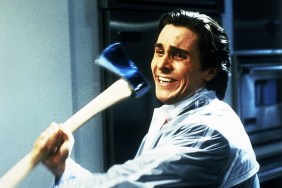In a season that is celebrating Captain America (Captain America: Civil War made $75 million just on Friday) it’s tempting – in a healthily cynical sort of way – to discuss all-American satire. That is, films that celebrate the darker and more outrageous aspects of all-American living. Crave recently reviewed Easy Rider in that regard, and, as an extension, we shall now also look at one of the more damning criticisms of American culture, Mary Harron’s 2000 horror/satire American Psycho.
Bret Easton Ellis’ novel on which American Psycho is based was first published in 1991, and was a violent damnation of the recently-ended Reagan era, which produced, through Reagan’s business-first policies, a generation of money-hungry, business obsessed narcissists. Ellis posited that wealthy white male yuppies were so depraved that they happily and enthusiastically committed some of the most horrid and violent acts of depravity and violence imaginable. Harron, in her adaptation, filtered this ultra-ego through the lens of male vanity, making it a general condemnation of masculinity.
Check Out: SoundTreks | The Carl Stalling Project
In Harron’s film, the main character, Patrick Bateman, played by Christian Bale, is not only obsessed with his own vanity, expensive clothing, and custom-made business cards, but also with the era’s pop music. Indeed, Bateman gives several well-thought-out critical analyses of ’80s pop hits throughout the film, spoofing the bourgeois tendency to over-intellectualize trivial matters. Music plays a big role in American Psycho.
What can listening to the film’s soundtrack reveal? We here at SoundTreks intend to find out.
Track 1. “You Spin Me Round (Like a Record)” – Dope
The original “You Spin Me Round” by Dead or Alive is one of the more notable one-hit-wonders in an era that was lousy with them. It’s a full-blast discotheque ball of glitter that most people can agree on. This version by the band Dope adapts it into Nu metal, complete with a brand new patina of sludge. Nu metal is, if you’ll recall, one of the more embarrassing musical trends to have arisen in the last 30 years. Since American Psycho is so dark, however, sludgy Nu metal may be appropriate. Indeed, you can almost feel the teeth on this one.
Track 3. “Something in the Air (American Psycho Remix)” – David Bowie
This is from David Bowie’s 22nd studio album, recorded in 1999, making it anachronistic for a film set in the 1980s. It’s surprising the music supervisors didn’t go with the more obvious “Let’s Dance,” or any of Bowie’s more era-appropriate hits. By including a new song – and a remixed one at that – we’re beginning to see the modern aspects of American Psycho. The evil, this song seems to be saying, is not something enclosed safely in the past. It is still here, and we’re going to growl about it.
Track 4. “Watching Me Fall (Underdog Remix)” – The Cure
Like the above Bowie track, we’re again eschewing more era-appropriate songs in the discography of a band that was active in the 1980s in favor of a new mood. This was a new song, released in 2000, on The Cure’s 11th studio album. The Cure, here and elsewhere, made dark, moody music (they are one of the Holy Quartet of Goth Rock, alongside Bauhaus, Joy Division, and The Smiths), and this long track feels less like a dance hit and more like a nightmare. Harron clearly didn’t want to merely use ’80s pop hits ironically (although that does happen), preferring to distantly evoke the ’80s through scary ’00s industrial fear music. The music, so far, seems to highlight the horror of the movie, and not the satire.
Track 5. “True Faith” – New Order
In American Psycho, Patrick Bateman discusses his favorite new music, which includes all the biggest hits of 1987. Phil Collins, Whitney Houston, and Huey Lewis are all mentioned. Bateman, in short, doesn’t have “cool” taste in music. His taste is meant, I think, to indicate how shallow he may be. From his blackened soul, however, we hear agony and hate and gleeful sadism. This is why, it seems, we are treated to New Order, the band that formed in the wake of Joy Division’s division. Industrial music and bleak mood rock for depressed kids. This is how Harron depicts the 1980s. It wasn’t all Kool and the Gang.
Track 7. “Trouble” – Daniel Ash
This record is shaping up to be one of the best Goth rock records you may be able to afford (if you really want to pony up the dough, go for Rhino’s Goth Box). Everything is eerie, terrifying, and evocative. As the record continues, the songs become more intense. This Daniel Ash track seems mellow, but there’s something off-putting and nightmarish about those processed vocals. Ash, by the way, is a former member of Love and Rockets. So there another scoop of cool for you.
Track 8. “Paid in Full (Coldcut Remix)” – Eric B. & Rakim
Eric B. & Rakim were a pair of underground ’80s rappers whose influence is overwhelming. I encourage you to look into them, as I haven’t the space to explore them here. This version does feature the raw, excellent ’80s rap sound, but the remix pulls the rap into something more moody. It, like the rest of the soundtrack, is a bit scary as a result. It feels like something that would be wafting around in the background when something uncomfortable is happening in the room. Or perhaps this interpretation is merely proof that the rest of the record is beginning to bleed into my brain and make me scared of everything.
Track 9. “Who Feelin’ It (Philip’s Psycho Mix)” – Tom Tom Club
Tom Tom Club was most certainly a New Wave band, originally formed as an adjunct of Talking Heads. You may know their ’80s hit “Genius of Love.” They continued to evolve over the years, however, and by 2000, were making more ambitious electronic-sounding tracks like this one.
I love the way this record is actively wrenching the 1980s into the present. In 2000 – as today – it was hip to prod the 1980s for its goofy one-hit-wonders, all while wallowing in nostalgia. New music by so-called “’80s” bands is not just a clever aesthetic strategy, but downright confrontational. It’s a call to prove that these bands are still cool, and they’ve actually matured as artists. And there’s much anger still pouring forth from their bones.
Track 11. “What’s on Your Mind (Pure Energy Mix)” – Information Society
“What’s on your Mind” by Information Society is a double-subversion. For one, it’s a 1980s hit that wasn’t released until 1988, making it an anachronism for a film set in 1987. Also, in 2000, Information Society had broken up, and weren’t to reform until 2006. This remix isn’t as dark or avant-garde as some of the tracks above. I don’t feel it’s a mere wallow in nostalgia. I appreciate that it’s not as aggressive as the rest of the record. I welcome the break.
Track 12. “Pump Up the Volume” – M|A|R|R|S
Okay. Maybe one nostalgia hit for fun.
Track 13. “Paid in Full (Remix)” – The Racket
And we exit as we entered, with a Nu metal cover of an ’80s song. All that comment I made about this track being nightmarish still applies, only here all the fear is buried under ugly fratty white boy rap-metal. It’s a pity we had to end here because this track kind of sucks. It’s not scary, the remix isn’t clever, and The Racket isn’t bringing much to the table.
Not Included: “Hip to Be Square” – Huey Lewis and the News
The elephant in the room is, of course, the exclusion of Huey Lewis’ “Hip to Be Square,” a song featured prominently in American Psycho. To work himself into a murderous frenzy, Patrick Bateman offers an analysis of the song, pointing out that it is indeed hip to be square. The song has become inextricably linked with American Psycho, and some find it baffling that the movie’s signature song is absent. Surely we should be ending with this seminal ’80s tune, yes?
As it turns out, the soundtrack record did indeed once include “Hip to Be Square.” Upon its initial release, the record included the song, but was quickly pulled from stores, rejiggered, and released with the song missing. It was rumored that Huey Lewis didn’t want people to associate his song with the movie anymore, but it turns out that’s not true. The song was excluded, in reality, for much more banal reasons. The production team cleared the rights to include the song in the film, but failed to include the soundtrack rights. It was just a litigious oversight. Huey Lewis did have the soundtrack withdrawn, but only because rights to his song had not been reserved. That’s fair.
Which is Better? The Soundtrack or the Movie?

Lionsgate
The movie is still better, as it’s easily one of the best horror films of the 2000s, but the soundtrack is only barely below it. This is a clever collection with more going on than you’d think from an initial glance. The music supervisor Barry Cole created several things at once: They made a record that eschewed the featherweight pop garbage of the 1980s while still evoking the era. They made wrenched the evils of the past into the present. They gave us a solid Goth collection. And they established the mood of a truly terrifying horror movie.
The mood is even better established with the few bits of dialogue included on the record. A few tracks are devoted to monologues from the film, a gambit employed by many 1990s soundtrack records, good and bad. Bateman’s inner monologue is so unabashedly fucked-up, however, that it can only make the music around it more unnerving.
It’s rare that a soundtrack record can manage to accomplish so much.
Top Image: Lionsgate
Witney Seibold is a contributor to the CraveOnline Film Channel, and the co-host of The B-Movies Podcast and Canceled Too Soon. He also contributes to Legion of Leia and to Blumhouse. You can follow him on “The Twitter” at @WitneySeibold, where he is slowly losing his mind.
Previously on SoundTreks:
SoundTreks
-
SoundTreks | All the 'Teenage Mutant Ninja Turtles' Theme Songs

The best Teenage Mutant Ninja Turtles theme song may very well be from a movie nobody liked...
Photo: New Line Cinema
-
SoundTreks | Easy Rider

How does the soundtrack to the seminal 1969 film play to a modern audience?
Photo: Columbia
-
SoundTreks | The Nice Guys

The Nice Guys is loaded with awesome '70s funk and disco. But is that old news?
Photo: Warner Bros.
-
SoundTreks | The Simpsons Sing the Blues

The Simpsons ventured into music very early in their run. How does this hit 1990 tie-in album sound 26 years later?
Photo: 20th Century Fox
-
SoundTreks | American Psycho

Does the soundtrack to American Psycho make one want to dance, or commit senseless acts of horrific violence?
Photo: Lionsgate
-
SoundTreks | The Carl Stalling Project

Carl Stalling wrote the music for most of the best Looney Tunes. Hence, you owe your childhood to him.
Photo: Warner Bros.
-
SoundTreks | William Shakespeare's Romeo + Juliet

SoundTreks, on Shakespeare's quadricentennial, looks at The Bard's most rockin' '90s soundtrack album.
Photo: 20th Century Fox
-
SoundTreks | Barbershop: The Next Cut

The soundtrack to the fourth Barbershop is full of soul, but is it better than the film?
Photo: Warner Bros.
-
SoundTreks | Space Jam

The Looney Tunes basketball movie is an affront to man and beast. Its soundtrack, however, may be worth saving.
Photo: Warner Bros.
-
SoundTreks | Everybody Wants Some!!

The soundtrack to Linklater's latest film attempts to encapsulate all early-'80s nostalgia in just 16 tracks.
Photo: Paramount
-
SoundTreks | Supercop

Remember that time America re-cut Jackie Chan's movies and made them worse? They had awesome soundtracks.
Photo: Dimension
-
SoundTreks | Batman (1989)

We love Batman. We love Prince. Two great tastes that tasted very weird together in 1989.
Photo: Warner Bros.
-
SoundTreks | Transformers: The Movie

Let's celebrate the Transformers phenomenon by listening to that weird-ass 1986 movie soundtrack.
Photo: Hasbro
-
The Top 10 Ennio Morricone Scores

Celebrate a master composer's first Oscar win by listening to Ennio Morricone's ten best movie scores.
Photo: The Weinstein Company
-
SoundTreks | Monty Python and the Holy Grail

On its 40 ½th anniversary, SoundTreks examines inventive and absurdist soundtrack to Monty Python and the Holy Grail.
Photo: Cinema 5 Distributing
-
SoundTreks | Marie Antoinette - Disc 1

Any multiple-volume soundtrack record probably rocks. How much does the first half of the OST of 2006's Marie Antoinette rock? Or shoegaze?
Photo: Columbia
-
SoundTreks | Zoolander

Is the soundtrack to Zoolander as painfully dated as Zoolander himself? SoundTreks investigates!
Photo: Paramount
-
SoundTreks | Deadpool

The anticipated R-rated superhero comedy has a fun, weird, kind of ironic soundtrack record. Let's listen.
Photo: 20th Century Fox
-
SoundTreks | Highlander

SoundTreks reviews at the best movie soundtrack that was never released.
Photo: 20th Century Fox
-
SoundTreks | The 2016 Oscar-Nominated Scores

Crave gave a serious listen to all the musical scores nominated at this year's Oscars, and selects the potential winner.
Photo: ABC
-
SoundTreks | The 2016 Oscar-Nominated Songs

Crave reviews the five songs nominated for this year's Best Song Oscar, and predicts the winner.
Photo: ABC
-
SoundTreks | The Best David Bowie Songs in Films

David Bowie's songs have been used in hundreds of movies and TV shows. These are some of the smartest uses of his music.
Photo: British Lion Films
-
SoundTreks | We Love Disney

Can Disney do justice to Disney with its latest tribute to the overwhelming awesomeness of Disney?
Photo: Disney
-
SoundTreks | Anomalisa

Can a soundtrack record also be an adaptation of the movie? Anomalisa attempts this unusual feat, and succeeds.
Photo: Paramount
-
SoundTreks | The Best Movie Soundtracks of 2015

The best movies don't always have the best soundtracks. Here are the eight most excellent soundtrack records of 2015.
Photo: Warner Bros.
-
SoundTreks | The Top 6 Christmas Songs from Film and Television

A lot of your favorite holiday standards were originally composed for movies or TV shows. Here are our six favorites.
Photo: Warner Bros. Television
-
SoundTreks | Fifty Shades of Grey

It was a hugely successful movie with a hugely successful soundtrack. But is that soundtrack actually any good?
Photo: Universal Pictures
-
SoundTreks | Elf

Is the soundtrack to this holiday favorite really a classic collection of Christmas standards?
Photo: New Line Cinema
-
SoundTreks | Streets of Fire

This rarely-celebrated 1984 cult movie - and its awesome soundtrack - deserves to be celebrated more.
Photo: Universal Pictures
-
SoundTreks | Glitter

Mariah Carey's musical is one of the most hated films of the 2000s. Is the soundtrack any better?
Photo: 20th Century Fox
-
SoundTreks | O Brother, Where Art Thou?

Who would have thought that obscure mountain bluegrass would make for one of the best soundtrack records of all time?
Photo: Buena Vista
-
SoundTreks | Pulp Fiction

Quentin Tarantino has been in the news a lot lately, so let's look at the legendary soundtrack record to his best movie.
Photo: MCA
-
SoundTreks | Twilight

Celebrate the 10th anniversary of Twilight with a review of the soundtrack, which is better than it has any right to be.
Photo: Summit Entertainment
-
SoundTreks | Rockula

There are very few horror musicals in the world, but the 1990 oddity 'Rockula' may be the best of them.
Photo: Cannon Films
-
SoundTreks | Zombie Nightmare

Does this crappy '80s zombie flick - once featured on Mystery Science Theater 3000 - have one of the best metal soundtracks of all time?
Photo: New World Pictures
-
SoundTreks | Danny Elfman – Music for a Darkened Theatre, Vol. 1

This compilation of Danny Elfman's early film and TV work reveals a composer we all miss, even though he's still working.
Photo: MCA
-
SoundTreks | The 10 Best Horror Movie Themes

SoundTreks peels back cinema's skin to reveal the creepiest, scariest, and just plain best horror movie theme music.
Photo: 20th Century Fox
-
SoundTreks | L.A. Confidential

Crime and jazz overlap in the excellent soundtrack to Curtis Hanson's 1997 classic.
Photo: Warner Bros.







